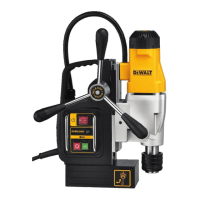29
• Keepthemagnetcleanandfreeofdebrisandswarf.
• Do not switch on the machine until it has been mounted and
installed according to the instructions.
• Do not switch on the machine before having checked that the
magnetic stand has been tightened firmly to the mounting surface.
• Adjustthetableordepthstoptopreventthedrillfromenteringthe
workpiece. Do not perform any design, assembly or construction
activities on the workpiece while the machine is switched on.
• Beforeswitchingonthemachine,makesuretheaccessoryhas
been mounted correctly.
• Alwaysusetherecommendedspeedfortheaccessoriesandthe
material.
• Donotusethemachineonthesameworkpieceonwhichelectric
welders are being used.
• Useonlyanappropriatecuttingfluid.Useageneralnon-oilbased
metal cutting coolant diluted with water.
• Donotuseliquidcuttingfluidswhiledrillingverticallyoroverhead.
Dip the cutter in cutting paste or apply an appropriate spray for
these applications.
• Donotpourcuttingfluidintothereservoirwhileitismountedinthe
bracket. Do not allow cutting fluid to enter the drill motor.
• Air vents often cover moving parts and should be avoided.
Loose clothes, jewelry or long hair can be caught in moving parts.
• An extension cord must have adequate wire size for safety.
Anundersizedcordwillcauseadropinlinevoltageresultinginloss
of power and overheating. When using more than one extension
to make up the total length, be sure each individual extension
contains at least the minimum wire size. The following table shows
the correct size to use depending on cord length and nameplate
ampere rating. If in doubt, use the next heavier gauge. The smaller
the gauge number, the heavier the cord.
Voltage (Volts)
Total length of cord in meters (m)
120–127V 0–7 7–15 15–30 30–50
220–240V 0–15 15–30 30–60 60–100
Rated Ampere
range
Minimal cross-sectional area of the
cord in meters (mm
2
)
0–6A 1.0 1.5 1.5 2.5
6–10A 1.0 1.5 2.5 4.0
10–12A 1.5 1.5 2.5 4.0
12–16A 2.5 4.0 Not Recommended
WARNING: If the plug or cord are damaged it must be replaced
by the manufacturer or its agent, or an equally qualified person to
avoid danger.
WARNING: Some dust created by power sanding, sawing,
grinding, drilling, and other construction activities contains chemicals
known to cause cancer, birth defects or other reproductive harm.
Some examples of these chemicals are:
• leadfromlead-basedpaints,
• crystalline silica from bricks and cement and other masonry
products, and
• arsenicandchromiumfromchemically-treatedlumber(CCA).
Your risk from these exposures varies, depending on how often you
do this type of work. To reduce your exposure to these chemicals:
work in a well ventilated area, and work with approved safety
equipment, such as those dust masks that are specially designed to
filter out microscopic particles.
• Avoid prolonged contact with dust from power sanding,
sawing, grinding, drilling, and other construction activities.
Wear protective clothing and wash exposed areas with
soap and water. Allowingdusttogetintoyourmouth,eyes,or
lay on the skin may promote absorption of harmful chemicals.

